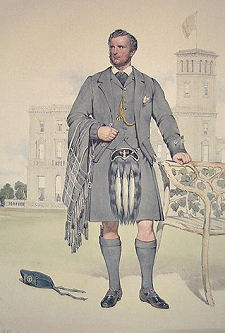 John Brown Sketched by Queen Victoria Note About Image Copyright |
John Brown lived from 8 December 1826 to 27 March 1883. A native of Crathienaird in Deeside, he was the second of the eleven children of tenant farmer John Brown and his wife Margaret Leys. After a variety of jobs as a farm labourer and ostler's assistant, John Brown became a stable boy on Sir Robert Gordon's estate at nearby Balmoral in 1842. The wider picture in Scotland at the time is set out in our Historical Timeline.
In 1848 the Balmoral Estate was leased by Queen Victoria and Prince Albert, and it was purchased by them in 1852. The Queen first mentioned Brown in her Journal on 11 September 1849, and from 1851 John Brown, at Albert's suggestion, took on the role of leading Queen Victoria's pony. In 1858, Brown became the personal ghillie (shooting guide and gun-loader) of Prince Albert.
After Prince Albert died in 1861, Queen Victoria went into deep mourning, becoming almost a recluse. In 1864, her daughter, Princess Alice, noted that the Queen had always been happy at Balmoral, especially when taking a ride in her pony cart. Why couldn't pony cart rides be made available at Windsor and at Osborne (the Queen's home on the Isle of Wight), with the Queen in the care of the man who so effectively led her pony at Balmoral? The Queen agreed and in December 1864 John Brown became a full-time servant. He was, as Queen Victoria put it in her journal, "indefatigable in his attendance and care".
By 1866 gossip about the relationship between the Queen and her extremely informal servant had started. Brown was the only person around Victoria prepared to "tell it like it was", and he often proved abrasive with members of the Royal Household: even, it is said, on at least one occasion giving the Prince of Wales the rough edge of his tongue. Rumours soon spread more widely, and Brown was featured in the satirical magazine Punch on 30 June 1866, and Queen Victoria came to be referred to by some members of her household (behind her back) as "Mrs Brown". Meanwhile, a Swiss newspaper went as far as suggesting that the two had actually married. "Mrs Brown" became the title of a 1997 film about the relationship, starring Dame Judi Dench as Queen Victoria and Billy Connolly as John Brown.
In 1872 John Brown knocked down a would-be assassin in what was the fifth attempt on Victoria's life. John died at Windsor Castle on 27 March 1883, aged 56, by some accounts because he was too devoted to Victoria. It is suggested that had he taken to his sick bed at the first sign of a chill, he would have survived, but his sense of duty was such that he carried on working until it was too late. He was buried at Crathie.
Were Queen Victoria and John Brown married? Yes, they probably were. This conclusion is based on four pieces of information, none of which is in itself conclusive, but which, taken together, help swing the balance of probability in favour of a wedding having taken place:
- After Victoria's death, two sets of mementos were placed in her coffin, at her request. On one side was placed one of Prince Albert's dressing gowns, while on the other was placed a lock of Brown's hair, along with a picture of him and a ring worn by Brown's mother and given to Victoria by Brown.
- The published diary of the Liberal MP, the 1st Viscount Harcourt, for 17 February 1885 related a second-hand story told to his father, the then Home Secretary, by a renowned gossip, that on his deathbed in 1872 the Revd Dr Norman Macleod, the chaplain to Queen Victoria, stated that he had conducted a marriage ceremony between John Brown and Queen Victoria.
- The Daily Mail on 2 September 2006 reported a similarly second-hand story in which a late senior member of the Royal Family had said that documents confirming a marriage had many years earlier turned up in the Royal archives at Windsor, and been destroyed.
- After Victoria's death (a full 18 years after John Brown's own death), Edward VII tried to destroy everything connected with Brown, including busts and photographs. A life-size statue of Brown at Balmoral, commissioned by Queen Victoria after his death, was only saved by being moved to an obscure part of the estate where Edward was unlikely to find it.


